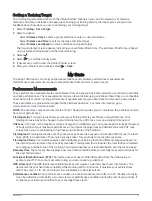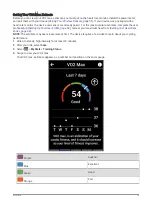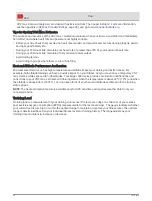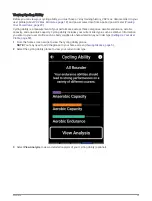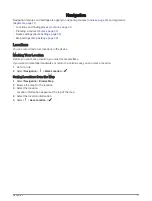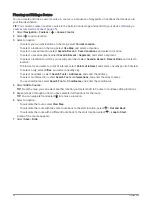
Red
Poor
VO2 max. data and analysis is provided with permission from The Cooper Institute
®
. For more information,
see the appendix (
VO2 Max. Standard Ratings, page 90
), and go to
Tips for Cycling VO2 Max. Estimates
The success and accuracy of the VO2 max. calculation improves when your ride is a sustained and moderately
hard effort, and where heart rate and power are not highly variable.
• Before your ride, check that your device, heart rate monitor, and power meter are functioning properly, paired,
and have good battery life.
• During your 20 minute ride, maintain your heart rate at greater than 70% of your maximum heart rate.
• During your 20 minute ride, maintain a fairly constant power output.
• Avoid rolling terrain.
• Avoid riding in groups where there is a lot of drafting.
Heat and Altitude Performance Acclimation
Environmental factors such as high temperature and altitude impact your training and performance. For
example, high altitude training can have a positive impact on your fitness, but you may notice a temporary VO2
max. decline while exposed to high altitudes. Your Edge 1040 device provides acclimation notifications and
corrections to your VO2 max. estimate and training status when the temperature is above 22ºC (72ºF) and when
the altitude is above 800 m (2625 ft.). You can keep track of your heat and altitude acclimation in the training
status glance.
NOTE: The heat acclimation feature is available only for GPS activities and requires weather data from your
connected phone.
Training Load
Training load is a measurement of your training volume over the last seven days. It is the sum of your excess
post-exercise oxygen consumption (EPOC) measurements for the last seven days. The gauge indicates whether
your current load is low, high, or within the optimal range to maintain or improve your fitness level. The optimal
range is determined based on your individual fitness level and training history. The range adjusts as your
training time and intensity increase or decrease.
20
My Stats












